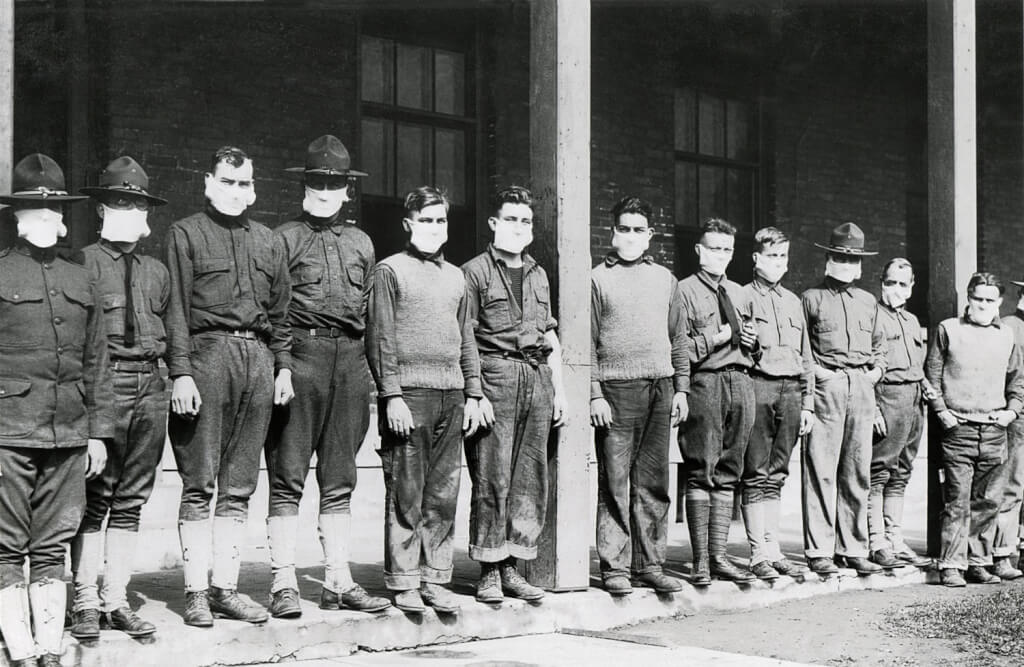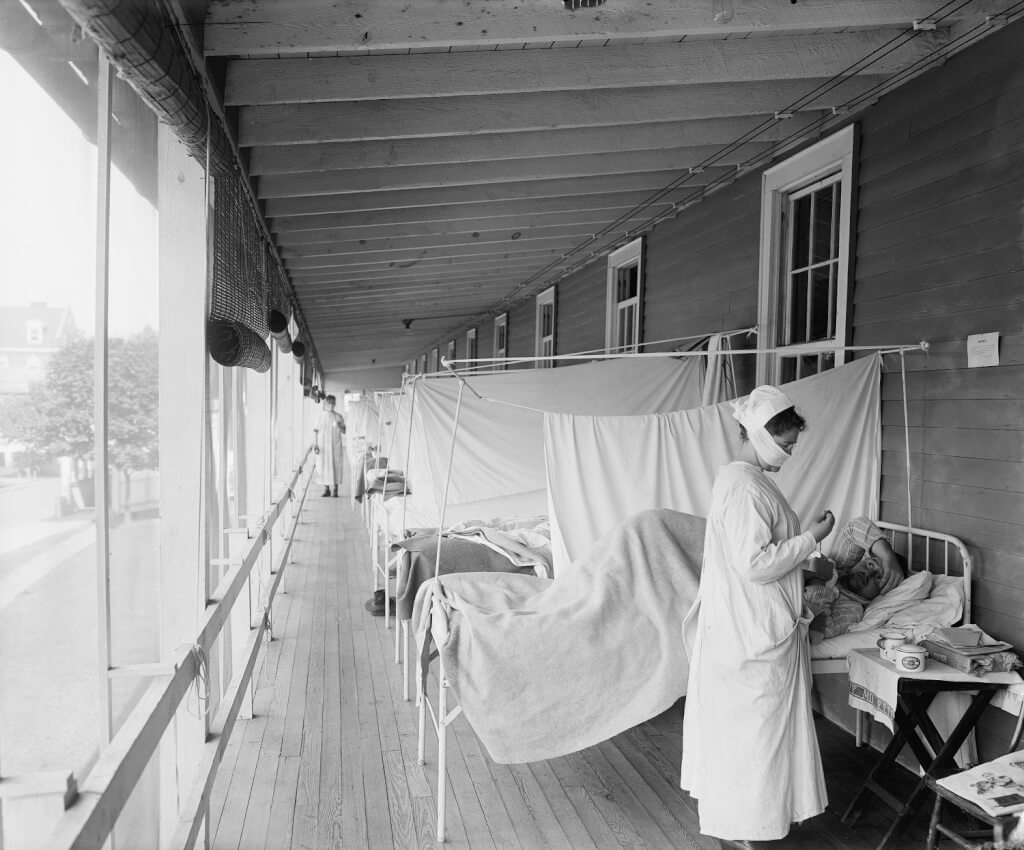The 'Spanish flu' pandemic in the USA: an epidemic everyone has heard about but knows little
'21.11.2020'
Source: Featured
Everything that we know about the famous "Spanish woman" is mostly speculation, assumptions and rumors. And then, in 1918-1919, they knew even less about her, says Featured.

Or just "flu"
In Spain, this type of flu is not commonly referred to as "Spanish flu". This name is generally accidental, the flu with the same probability could become both "Italian" and "German", rather even "American".
Some researchers believe the Spanish flu originated in the United States. Others believe that she was transferred there from the East, from China. Indeed, similar symptoms were seen in China as early as 1917. And the labor migration of Chinese coolies (unskilled workers) to America at that time was colossal. However, Great Britain was not far behind either.
At first, the infection was called differently - "blue death", "purple death", "mosquito fever" or simply "flu".
There is a canonical version of the beginning of a pandemic. A kitchen worker, Private Albert Gitchell, came to the hospital at the Fort Riley military base (America, Kansas). He complained of sore throat, coughing and chills - common symptoms with a cold.
A few hours later a second soldier arrived with exactly the same symptoms. Then another dozen. And soon the hospital ran out of free beds.
In the first week, 500 people came down with the disease there.
“They call it the 'three-day fever', but you can't fool anyone with that, because sometimes it lasts for a week or even longer. The disease comes on suddenly, and the patient's temperature rises so much that mercury almost breaks through the top of the thermometer, the face turns red, each bone begins to ache, and the head just breaks. This continues for three or four days, and then, after thoroughly sweating, the patient recovers, although the "hangover" can still be felt for a week or two, "the soldier complained in a letter to his relatives.
Why is the Spanish flu? The fact is that Spain in the First World War remained neutral and, accordingly, a strict censorship regime was not introduced in the country. All the newspapers shouted about the disaster, while the press of other European countries was diligently silent. Even though the flu was even worse there, life in trenches, barracks and displaced persons camps made it flourish.
On the subject: 'Poisonous air': how ignorance and prejudice helped the plague destroy millions of people
However, the first newspaper report about the “Spaniard” looked encouraging: “A strange disease has been discovered in Madrid. The epidemic is spreading fairly easily with no deaths reported yet. ”
Death from aspirin
The Spaniard looked scary. In a matter of hours, the person developed a severe bloody cough. There was not enough air, the face became cyanotic due to suffocation. In some cases, a person died precisely from a lack of oxygen. In some, he choked on his own blood.
“The most sinister type of pneumonia known to medical science is developing. Two hours after hospitalization, reddish spots appear on their cheekbones, and after a few more hours one can observe cyanosis (blue discoloration of the skin and mucous membranes. - Approx. Ed.) begins to spread from the ears all over the face to such an extent that it is impossible to distinguish a white man from a black man. After that, death soon follows. Breathing becomes more and more difficult and the patient suffocates to death. This is terrible. You can endure the sight of the death of one, two or even twenty people, but these poor fellows are dying like flies, and such a sight is simply maddening. On average, we are now registering about a hundred deaths per day, but their number continues to grow, ”wrote one military doctor.
And it happened that even without a particularly pronounced symptomatology, a sick person calmly recovered.
The so-called spring wave was more or less bearable. It seemed that the flu was about to be defeated. But in August 1918, it all began with renewed vigor. The virus mutated sharply. The death rate has increased significantly. The spread of the infection too.
On the subject: DNA examination and diagnosis of coronavirus: what is a PCR test and how it works
The "Autumn Wave" paralyzed almost all of Europe, West Africa and part of the United States of America. There were practically no dangerous complications - pneumonia, meningitis.
There was no experience in dealing with such a flu. Doctors and governments of different countries acted on a whim, sometimes their actions only made the situation worse.
Basically, of course, everything was aimed at reducing contacts between people. Schools, institutes, theaters and cinemas, as well as churches, museums and even courts were closed for a year or more. Handshaking was prohibited in some places. Common toothbrushes (and this was practiced) were replaced with individual ones. The same applied to dishes. In some cities, people without medical masks were not allowed into vehicles.
It was assumed that this was not the flu at all, but some kind of mysterious "pneumonic plague", that the Germans poisoned the water or sprayed poisons in the air, released the virus in theaters, threw contaminated canned food onto the market. Alternatively, the Germans poisoned the fish in the rivers.
In Germany it was about the same, but only the British were accused. There was a lot of reasoning about the fact that "God was angry."
In wild quantities, patients were given aspirin - up to 30 grams per day. The maximum permissible daily dose is about four grams, but then they simply did not know about it. People got sick with the flu and died from aspirin overdose.
There was no vaccine, they only tried to create it, somehow blindly grope for the formula, but all to no avail. More or less, blood transfusions from recovering patients to just sick people worked. It happened that blood and mucus were mixed. From such an injection, the injection site was terribly inflamed. This was considered a good sign that the drug had worked.
On the subject: 'The body is flying apart': why the coronavirus can kill people who have already recovered
They were allowed to breathe in small doses of chlorine, the poison burned out the infected mucous membrane of the respiratory organs along with bacteria, and for some time the patient acquired the ability to breathe. But it was not always possible to dose correctly.
More often than not, they simply bled and gave oxygen.
“We didn't have time to heal them. We did not measure the temperature and did not even have time to measure the pressure. All they could do was give them a hot whiskey. And they had terrible nosebleeds. Sometimes the blood just flew across the room, ”wrote Nurse Josie Brown.

Harmed itself and the human body. This is also no more than a guess, but it explains one surprising fact. The fact is that with the usual flu, children, the elderly and weakened people are at the maximum risk group. Here, the opposite is true, representatives of these categories often survived, and died young and healthy. The highest death rate from the Spanish flu was in the 20-40 age group.
Presumably, the "Spanish flu" so excited the patient's immunity that he, along with disease-causing viruses, destroyed his own lungs. And in children and old people, the immune system was not able to act with such power, and they recovered.
Many have argued that the main reason was precisely the war. Other researchers refuted this, referring, in general, to an obvious fact: there was no war in America, and the number of victims was 775 thousand against 426 thousand in Germany.
On the subject: 'There will be no herd immunity': scientists have revised the concept of combating the pandemic
The situation cleared up a bit in 1997, when the corpse of an infected woman preserved in the permafrost was found in Alaska. As a result, a sample of the 1 H1N1918 virus was obtained.
But this, of course, did not clarify the full picture of the world tragedy.
"Obviously Spanish"
And what about Russia? Unfortunately, everything is the same as in Europe. Perhaps to a lesser extent, since by 1918 the First World War had already turned into a civil war, but it still had its own specifics.
There was not that catastrophic concentration of soldiers in barracks and trenches. The general confusion was “favorable” for the statistics. Who died there from what - from the insidious "Spanish flu" or just the peasants raised them on a pitchfork?
The famous actress Vera Kholodnaya died from the "Spanish woman" at the age of 25. It was rumored that she was poisoned by lilies, which the rejected lover presented to the actress.
“There was a real epidemic in Odessa, and the disease was very difficult, but Vera was somehow especially hard. Professors Korovitsky and Uskov said that the “Spanish flu” was passing through her like pneumonic plague ... Everything was done to save her. How she wanted to live! " - wrote the sister of the actress.
The same illness claimed the life of Yakov Sverdlov.
Literary characters did not lag behind real people. For example, Sanya Grigoriev from "Two Captains" by Veniamin Kaverin:
“I seem to have vomited, or maybe not. I only remember that I was sitting in the snow, and someone was holding me by the shoulders, because I was falling. Finally they stopped holding me, I lay down and stretched my legs with pleasure. Something was said over me, as if: "Seizure, seizure ..." Then a man's voice said: "Obviously Spanish."
And everything failed ... "
Indirectly, the disease was also mentioned in The Golden Calf by Ilf and Petrov: “The spontaneous forces became angrier and more dangerous: the winters were colder than before, the wind was blowing stronger, and the cold that used to put a person to bed for three days, now in the same three day killed him. "
French poets Guillaume Apollinaire and Edmond Rostand fell victim to the pandemic. The King of Spain Alfonso XIII also got sick with the Spanish flu. The monarch, fortunately, survived.
The Norwegian artist Edvard Munch, who has recently become unexpectedly popular, also survived. And even wrote in 1919 "Self-portrait after the Spanish flu."
On the subject: 8 reasons why we will age easier than our mothers and grandmothers
The Spanish flu pandemic is considered the most massive in the entire history of civilization. For a year and a half, about 550 million people fell ill around the world - slightly less than a third of the world's population. About 50 million people have died from the Spanish flu.
A driver from Cape Town claimed that six people died on his train during the five-kilometer route. In Barcelona, 1200 people died a day. The Australian doctor met 26 funeral processions in an hour. Whole cities did not die out, but whole villages - yes, it happened.
“Find any suitable joiner or carpenter and order the coffins to be made. Then take some road workers and have them dig graves. Only then will you have a chance that the number of corpses will not grow so fast that you cannot bury them, ”wrote one American doctor at the time.
And here are the recollections of another eyewitness: “I had to start up special trains to take out the dead. The coffins were not brought up for several days, and the bodies kept piling up, and, entering the morgue (it is just behind my room), we could more than once contemplate the unfortunate boys, laid in long rows. You will not see this even after the fiercest fighting in France. Then the largest barracks were freed under the morgues, and hardly anyone could have remained indifferent if he had a chance to walk along the corpses, dressed in uniforms and stacked in piles by two. "
Graves were often dug with excavators; nobody could afford the luxury of a personal gravedigger. By the way, they also died, the cities were suddenly left without a single gravedigger. Or worse, without a single doctor.
And in the spring of 1919, the epidemic suddenly ended. As unexpected as it began. And it is just as unclear why.







